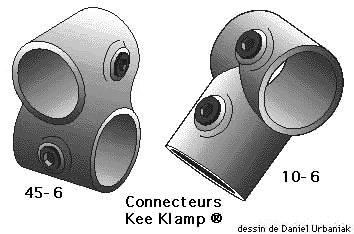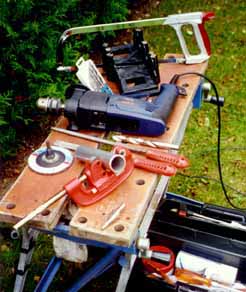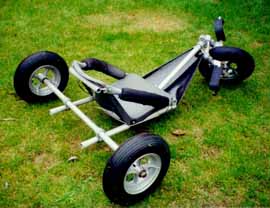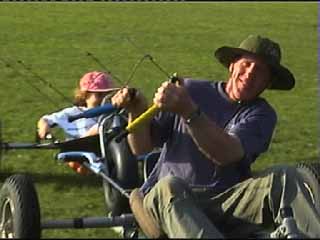|

With the permission of Sylvian
Bouju I made an english version of his page.
The buggy is the work of Sylvian Bouju.
This english text is my interpretation of his work.
Or go for another french version from Daniel Urbanlak.
This buggy is build and constructed by Sylvian Bouju. The objective was to build a buggy with normal home
tools and which could be build easy by anyone. Without the need to weld, without machined parts. Just parts
from your local hardware store, bicycle store and the kite store (wheels). The construction plan is easy to
understand. You only need the time to build it and some money to buy the parts. Check the original plans for
changes. You get a comfortable buggy. It is heavier then a retail stainless steel buggy but it is cheaper and
home made...
This construction is based on tubes with 35 mm external diameter (from airplane aloy, Dural, AU4G, or aloy
2017, ...) and British slip-on fittings from Kee Klamp® (number 6), 3 wheels from a kite shop and a one
piece plastic (polypropylene) seat. This is all you need to make this buggy.

|
Required tools:
a portable workbench (WorkMate),
a tube cutter,
a metal saw,
some files (square and round),
an electric drillmachine
(with metal bits, sand disk,
metal punch, ...) and
all available from
the local hardware store.
Don't forget use....
"eye-protection" !!
|
 |
|
|
 |
Final remarks:
Look carefully at the pictures and study
them well. Check the angles and the geometry
before you assemble all. But don't forget
your own inspiration. Use your brains.
Don't be afraid to change the plan here
or there. Change the angle between tubes
5 and 7 of the frontfork to get very direct
(stunt) or indirect steering (high speed).
|
The above photo shows the "Slow Brain" buggy from behind. Check the added accessories.
- a front fork steering angle limiter, needed to race in class 8 (France), and realized with a rubber
silent-block (under the downtube close to the front fork).
- a guard to protect against water and mud from the front wheel.
- foot pegs with anti skid and elastic foot-straps, all from a bicycle shop.
- a piece of PVC tube put behind the back of the seat to limit its flexibility and to reinforce it.
The buggy, build in june 1997, has been test driven for a total, at the end of oktober 1997, of approx. 800
km. No problems, of what ever kind, have been shown. The buggy was used during the Kite Festival week at La
Franqui, the raid Barneville-Granville and the Buggy Grand Prix of Quiberon.
This design of tubes and fittings allows to put on other accessories easily. For instance a bag with lunch,
drinks, kite lines, etc. Or some splash/mudguard. Or a spare wheel. Or convert it into a 2 wheel buggy with 1
big foot wheel in the back. Or convert it into a mini size buggy. Or an extra large buggy for the long or wide
one's. And maybe you have some idea's too.
Building instructions.
FAQ
- How much will it cost to build one ?
If you forget the 1st version then Sylvian estimates he can build one for approx. 2000 Franc. A lot of money
went to the Alroc wheels but if you would buy the wheels for say 5 buggy's you could negotiate and come up
with a price of 1500 Franc for each buggy.
And if you don't have the tools and have to buy them as well then better consider the Peter Lynn classic
buggy that sells now for around 2000 Franc.
- The Kee Klamp fittings 10.6 or 45.6 fitt tubes with 33.2 mm diamter according to the Kee Klamp
documentation. Why do you use 35 mm ?
The 33.2 tube has a big tolerance with the fitting where as the 35 mm has just a little. You may even have to
use a file (for the inside of the fitting) to get the perfect fit.
- Can the buggy be disassembled ?
Sylvian never does that. Only the wheels and the front fork. The frame stays as it is.
Notes
- The overall performance and rigidity of the buggy are very good. The only weakness so far are the driver
and the kites he uses.
- Corrosion did some work but is not a problem.
- The rear-axle is changed from 1 meter to 1.20 meter. But some jumps with the buggy bent the rear-axle and
give it a negative camber ( /---\ ). But I can turn the rear-axle around and change it to positive ( \---/
).
- Tubes 2 and 4 endure much. So tube number 4 is changed from 35x2 mm into 35x5 mm (the same as tube 2).
The tubes are fixed at their position by drilling through the fitting and the tube and secured it with a
split pin.
- The PVC tubes 10 and 11 are showing hair cracks, little by little. This is probably caused by overheating
them while they were curved, a little, over the gaz heater.
- At the rear-axle every Nylstop nut is replace by a double stainless steel version without Nyl(on)stop.
This allows to tighten the nuts when needed and makes disassembly more easy.
- 20 september 1998 the master himself, Peter Lynn, driving the buggy 'Slow-Brain" at the
"Journées du Vent" in Saclay au Val d'Albian...
Using Sylvians C-Quad and pulling Sylvians Peter Lynn Competition, he was so kind to take several children in
a 'first time' ride with this combination.


Some useful addresses:
Weber A. Métaux (tubes AU4G, fittings, bolts, nuts, tools...)
9, rue du Poitou - 75003 Paris
66, rue de Turenne - 75003 Paris
Tél. : 01 42 71 23 45
34, rue M. Gunsbourg - 94200 Ivry sur Seine
Tél. : 01 46 72 34 00
Kee Klamp Limited 10 Worton Drive, Worton Grange, Reading, Berkshire, U.K.
+44 (0) 118 9311022 (tel) +44 (0) 118 9311146 (fax)
http://www.kee-klamp.com/
Sofreco (Importer of the fittings Kee Klamp® for France)
Z.A. Le terminal
30, Av. de Bobigny - 93130 Noisy-le-Sec
Tél. : 01 41 83 20 90 - Fax : 01 41 83 20 51
DE MELKER BV. (Importer of the fittings Kee Klamp® for Benelux)
De Schutterij 20
Postbus 65
3900 AB Veenenedaal (Nederland)
Tel : 0318/52.48.00 - fax : 0318/52.50.35
Alroc - Roux S.A. (wheels)
4, rue de la Fonderie - 72160 Tuffé
Tél. : 02 43 71 11 80 - Fax : 02 43 71 16 51
Daniel Urbaniak, PAO, 3D, graphics, illustrations (needs a job...)
Tél. : 01 39 53 76 82
Sylvain Bouju: sb10@calva.net
|


